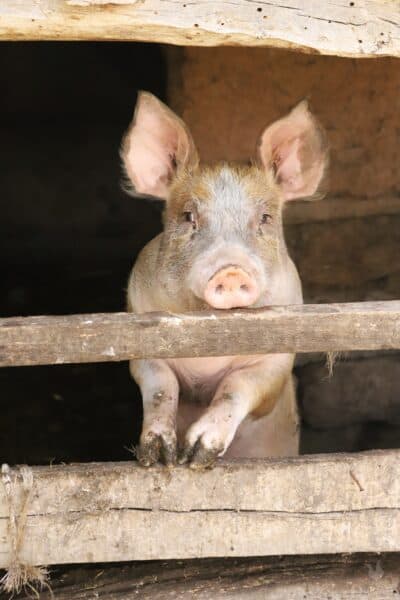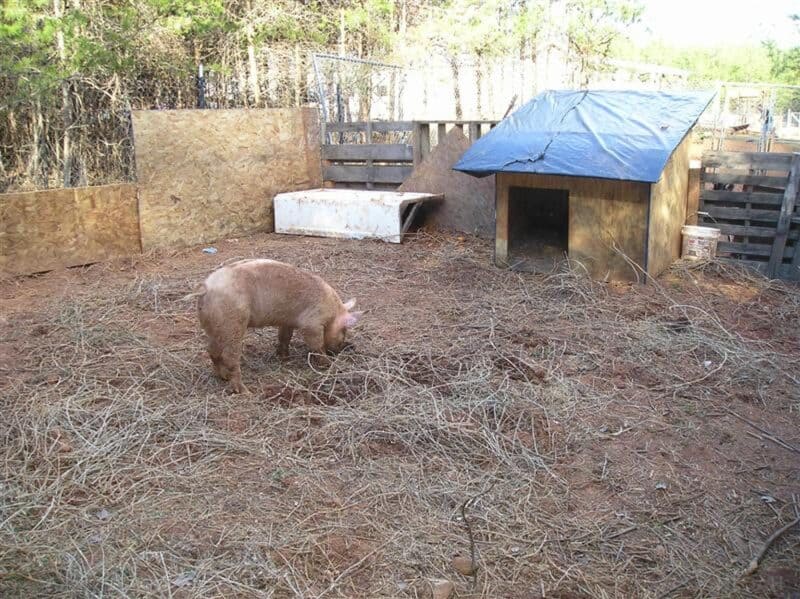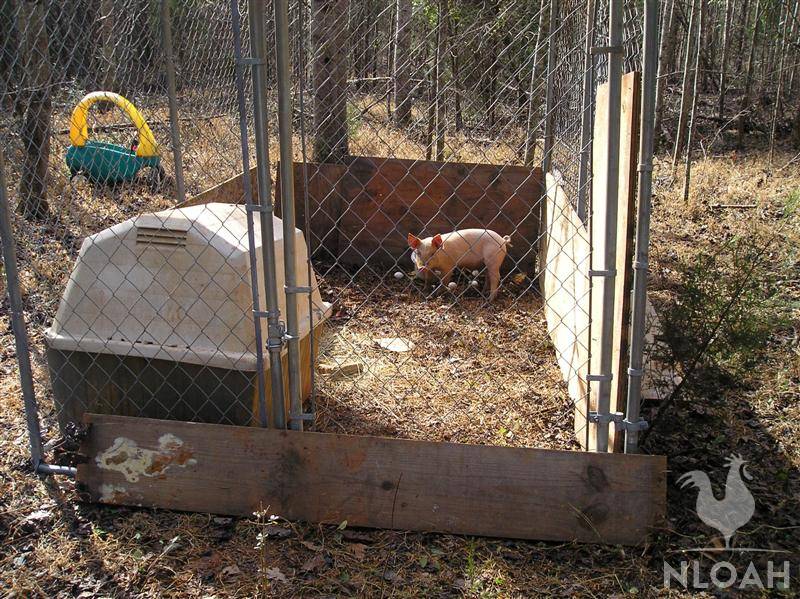Housing For Your Pigs: What You Need to Know


Keeping animals on your homestead safely and efficiently is mostly a matter of keeping them contained. With very few exceptions, if your animals aren’t properly housed, they will wander off and get into trouble, get hurt, or get lost.
Different livestock species require a different approach, and when it comes to pigs specifically, you’ll have your work cut out for you.
Pigs are highly intelligent, very strong, and have a propensity to make a huge mess if you haven’t set up their accommodations correctly. This can lead to disaster both for you and them…
Luckily, housing your hogs is more science than art, and you won’t have to guess at it since you’ll have all the info in this guide at your disposal. Pull on your boots and let’s get a move on.
Before you do absolutely anything else, the first thing you need to consider when it comes to housing your pigs is location. That’s what they say about picking the right real estate: it’s all location, location, location!
In this case, you want to situate your pigs so that their accommodations stay cleaner, drier, and you don’t have to put up with their stench being too close to your house.
This means you’ll want to situate their pen or other enclosure on ground that is well-drained, not prone to flooding, not subjected to groundwater, and preferably downwind of your home.
Bonus points if you can do all of that and also place it so that your workflow for them and elsewhere on your homestead is still easy and convenient.
Before we start laying down the first fencing panel or first plank of a shelter, it pays to understand how pigs interact with their environment, specifically a man-made one.
Basically, pigs live pretty regimented lives. They like having some open area to roam around in, root and explore, a dedicated area for sleeping and nesting, a place to poop, and a place to eat and drink.
Usually, the area where they poop is not too far away from the area where they drink and eat, but as far as possible from where they sleep assuming they have enough room.
Because of their unique method of “housekeeping,” you are wise to build a rectangular enclosure for them. Put the food and water at the far end in one corner, and this will allow them to use the opposite corner on that end for defecation.
They will sleep on the side opposite both of those locations and roam around and explore in the middle. IT will also make cleaning up the pen easier and keep the pigs happier.

One of the most important factors to calculate when keeping pigs is how much space they will need. Hogs need enough room to move around and turn around comfortably, and also a little bit of personal space so they aren’t crammed in shoulder to shoulder.
Herds that don’t have enough room will be stressed out, more prone to get sick, show slower growth, and often become more aggressive with each other and people. You don’t want any of that to happen!
The following are minimum space requirements for pigs based on your approach and your goals:
At the absolute minimum, adult pigs need eight square feet of space to themselves, even if they are kept inside a shelter.
This is the most commonly quoted figure for what is called confinement farming, where pigs are given only the bare minimum of room needed to minimize stress and ensure steady weight gain.
It’s viable if you have very little space for your herd on the property and plan on slaughtering pigs as soon as they reach market weight, but it’s not a very good life for the pigs themselves.
A much better and more sustainable figure for keeping your pigs happy and healthy is to allow them 80 square feet per adult. This is workable in a modest outdoor pen or if you are keeping them inside a larger structure like a barn or large shed.
This will let each pig stretch out, move around freely, and have plenty of personal space if there are disputes or flaring tempers in the herd.
Plus, your pigs will be happier, and that will make them healthier, easier to handle, and help them gain weight quicker.
One of the best things you can do for your animals generally, and also a great thing for the quality of the pork they produce, is to let them free range on a pasture.
The rule of thumb is that you can keep two to three adult pigs on a quarter acre, meaning anywhere from 8 to 12 on a single acre.
Pasture-raised hogs are able to supply some or most of their nutritional needs depending on the quality of your land and how much space they have.
But pigs are big eaters and highly destructive besides, and that’s because they root and dig like no other animals!
Keep too many heads on any given patch of land for too long, and they will destroy the plant life there utterly, meaning it won’t regenerate without intensive cultivation and rehabilitation.
Regularly rotating your pasture will keep your pigs happy and your plant life regrowing for next time.
Yes, they do! Or rather, any pig, regardless of breed, over a certain weight will need more room to remain comfortable. Once a pig is over 250 lb, it will need more space.
Luckily, this is a pretty easy calculation. Simply increase the square footage minimums above by 15% to 20%.
For example, in close confinement, these larger porkers would need at least 10 sqft. A better figure if you want to allow them more room would be 96 sqft. Plan on keeping no more than six or eight very large pigs on an acre.
Whatever kind of pen shape and style you are going for, you’ve got to choose strong fencing to keep your pigs contained. They are strong, curious, intelligent, and will test it!
Lots of veteran pig keepers, yours truly included, rely on electric fencing because it keeps pigs in place using a strong pain avoidance incentive.
Three energized strands of polywire to a side will keep nearly any pig inside and away from the edges of their enclosure as long as it is functional.
No matter how many times they get popped, though, depend on pigs getting bold and testing it again in the future. If it’s off or out of action, they will get out!
As a backup to electric fencing, or in lieu of it if you don’t want to mess with it, use hog panels. These heavy-duty metal grid fence panels have much smaller openings at the bottom and larger ones at the top. Those smaller ones will keep piglets inside.
These are tough enough to resist all but the most monstrous hogs, but they are only as good as the fence posts you put them up with
Any fence post you use, whether wood or metal, must be deeply sunk in the ground and preferably in concrete to resist digging attempts which could weaken it.
If you plan on keeping your pigs on pasture, you can save a fortune by going with electric fencing because it’s easy to reposition to make paddocks for rotational grazing.
Commonly overlooked by beginning keepers, pigs must have shade from direct sunlight! Pigs with pink or white skin are very prone to getting sunburned, and in any case, direct sunlight will induce heat stress in time, particularly if air temperatures are already hot and humid.
Believe it or not, most adult pigs are only comfortable and safe in temperatures up to 75°F. Anything hotter, especially in direct sunlight, and they can start suffering from heat exhaustion and eventually heat stroke.
Shade from buildings, trees, awnings, or even a tarp that you hang up will help them stay cool, especially in conjunction with a wallow. They’ll dig that themselves, don’t worry!
Yes, they do. As tough and adaptable as they are, pigs need shelter year-round, both in the warm seasons and in the cold seasons. Shelter is particularly important in the summer when it’s swelteringly hot, and in the winter when it’s blisteringly cold.
Summer shelter for your pigs can be really simple, just something that will allow a good breeze to get through, give them plenty of shade to get in out of the sun, and keep the rain off of them.
A three-sided running shelter is typical and in many ways ideal. A taller roof will let heat rise up and away from them when they want to stay cool.
Keep a layer of clean straw on the ground to help keep moisture under control, or if you want to use a solid floor, make sure it is slatted so that water, droppings, and pee can drain away.
A winter shelter is not much different from a summer shelter, but it does need a few special adaptations if you live in an area with particularly harsh winter weather.
A steeply sloped roof that will keep snow from accumulating is a good idea, and you should also install a flap or curtain that will help keep snow and frigid wind from blowing in through the entrance.
Speaking of, it’s particularly important to position a winter shelter so it faces away from the prevailing wind.
Adult pigs do just fine in colder weather, and when they huddle up inside to stay warm, they’ll easily warm up the space, but they’ll have an easier time keeping warm if you have an extra thick layer of fresh, dry straw down for them.
It’s possible to convert a summer shelter to winter duty with the right approach, and you don’t necessarily need to build a new one. Check the next section for details.

A poorly outfitted shelter will make for miserable, cranky, and likely sick pigs. Do the following to winterize their shelter and get it ready for the cold season:
Snow that accumulates on the roof of the shelter might start to melt from rising body heat, and this can cause drips that will slowly soak and eventually saturate the bedding and then the ground inside.
That will lead to miserable, cold pigs…
Make sure the roof is properly maintained, and replace cladding, tarps, or any other components as necessary to stop leaks. Note that this is much easier to do before winter arrives and snow is actually on the roof, so consider this a good fall chore.
Pigs will be spending more time in the shelter during the winter, and the entrance is more likely to be covered, so ventilation is even more important.
For smaller shelters, vents or ports near the roofline should be adequate. Larger sheds or barns may need electrically powered blower fans or convection vents that are spun by rising warm air.
You need ventilation in the shelter, but at the same time, you want to prevent drafts that are low to the ground or floor which can chill pigs, especially piglets and weaners.
If the pen is made of wood or other sturdy materials, give it a pass with a caulking gun, weather stripping, expanding foam, and other materials that can stop cold air from seeping in.
A good tip given to me by my old mentor is to raise the sleeping surface off the ground by several inches, even if you already have a hard floor in the shelter. This will help pigs stay warmer by preventing heat loss to the much colder ground.
To do this, you could build a simple plank floor using bricks or wood fence posts as a foundation, then layer the pig’s bedding on top of that.
I know some folks have used pallets, but I am wary of them because of the nails they contain. I do have a neighbor who used big, wide, shallow plastic shipping crates flipped upside down for the same purpose, and they were both durable and easy to clean.
There’s no such thing as too much good bedding for pigs in the winter. Provide extra so they can make a thick, warm, and comfortable place to sleep or nest in, and stay on top of mucking it out once it gets wet and soiled.
Also, make sure you properly dispose of soiled bedding rather than just dragging it out of the shelter and leaving it lying around; pigs tend to gather loose material like straw, hay, and grass for bedding when it’s cold, and you don’t want them dragging it back in!
Don’t be surprised to see your pigs out and about running around even when there is snow on the ground. It won’t really bother them too much unless they’re forced to stay in it for a long time.
However, deep snow can be problematic and annoying for them. Pigs are strong, but they have short legs, and plowing through snow is tiring for them.
Make things easy for them by shoveling deep snow out of their pen or at the very least creating a path to and from the shelter from their food and pooping areas.
This makes it more likely that they’ll get up and actually move around rather than enter a semi-hibernation state when it gets really cold…
You must provide specialized and separate housing for a sow that is expecting piglets. This is for the safety of mother and babies because you don’t want other pigs getting near them. This will lead to fights and stress which can have disastrous results for mom and the little ones.
If you are keeping your pigs in a barn, you can make a separate pen for them far from the other pigs and out of sight. About 8×8 feet is plenty of room.
If your pigs stay outside most of the time and make use of a smaller shelter, consider creating a separate paddock for mom and a shelter of her own. Something the size of a large dog house should be adequate.
Whatever kind of shelter arrangements you make, just make sure that it is quiet, safe, and very warm: piglets are extremely vulnerable to cold as mentioned.
This is one time when you might need to provide supplemental heat in the form of an overhead heat lamp or a specialized area heater intended for livestock use.
Whichever one you go with, it is critical that all cords and cables be secured or placed entirely out of reach from pigs to prevent accidents.

Tom has lived and worked on farms and homesteads from the Carolinas to Kentucky and beyond. He is passionate about helping people prepare for tough times by embracing lifestyles of self-sufficiency.
